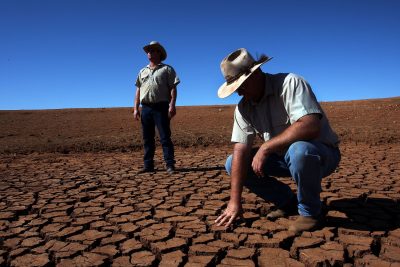The Lasting Condition: Drought in Australia

Note to readers: please click the share buttons above
Humans are a funny species. They create settlements along fault lines that, on moving, can create catastrophe, killing thousands. They construct homes facing rivers that will, at some point, break their banks, carrying of their precious property. Importantly, they return in the aftermath. Existence continues.
The same follows certain settlements of parts of the planet where hostile, environmental conditions discourage rather than endorse a certain form of living. Changes in weather have been vicious catalysts for the collapse of civilisations; extreme climactic variations prevent and retard stable and sustainable agriculture.
“The flourishing of human civilisation from about 10,000 years ago, and in particular from 7,000 years ago,” notes earth and paleo-climate scientist Andrew Glikson, “critically depended on stabilisation of climate conditions”.
This had its due results: planting and harvesting of seed; cultivation of crops; the growth of villages and towns.
Australia, the second driest continent on the planet, has never been exempt from such patterns of disruption, and those stubborn, pluckily foolish farmers who persist in the notion that they can make a living in parts of it risk going the same way.
Australia’s agrarian purveyors have certainly been persistent, hopeful as pilgrims in search of holy land. Disasters have not discouraged. A sense of a certain attendant fatalism can be found in the scribbles of Nancy Fotheringham Cato’s “Mallee Farmer”:
You cleared the mallee and the sand blew over
Fence and road to the slow green river;
You prayed for rain but the sky breathed dust
Of long dead farmers and soil’s red rust.
You ploughed up the paddocks with a stump jump plough
But the gates were open and the drought walked through.
The Settlement Drought (1790-1793) threatened but did not overwhelm early European settlers. The Goyder Line Drought (1861-5) savaged but did not kill farming in parts of South Australia. The recent Millennium drought (1997-2009) was spectacularly ruinous, but Australian agriculture moaned and stuttered along.
Farming in Australia remains precarious, an occupation of permanent contingency. Droughts ravage, kill and annihilate. Crops and livestock perish with gruesome ease. But the Australian farmer, rather than being portrayed as a dinosaur awaiting extinction, is seen as resilient, durable and innovative. Yet each drought brings a certain narrative.
One aspect of that narrative is the sense of singularity. Droughts are often seen as unprecedented. This alleviates the need to consider stark realities and inefficiencies that characterise the problem of farming in naturally dry environs with inappropriate crops or livestock, to up stakes, as it were, and finally admit to the brutalities. Such determination often flies in the face of the work conducted by climate science researchers, who tend to occupy a certain high terrain of gloom. Recent publications float the suggestion that the droughts this year may be some of the worst in 800 years.
The response from the prime minister has been an urging against the predations of nature: to fortify “resilience” in light of more unpredictable rainfall. The fear from such figures as former Nationals leader John Anderson is that matters of climate change will be co-opted in an act of politicisation. This would suggest inevitability, doom and acceptance.
Climate change watchers Andrew King, Anna Ukkola and Ben Henley do not shed much light on these matters, logically pointingout that drought, being a “complex beast” can be “measured in a variety of ways. Some aspects of drought are linked to climate change; others are not.” The entire field of drought studies reads like a sophisticated, taxonomical manual of expertise and foreboding, noting variations in their spatial effects, duration, seasonality and intensity.
Such studies are intriguing, and tend to ignore the withering human consequences that invariably follow. Figures like Edwina Robertson of Trangie, west of Dubbo supply the viewer with a pathos and desperation, her tears the only moisture in an arid setting. The Prime Minister, Malcolm Turnbull, was there to capitalise.
“It’s worse,” he was told, “than anything you are seeing in the media, it’s far worse.”
Drought brings with it a whole platoon of agents and variables. Cash relief payments are provided through the Farm Household Allowance (additional payments of up to $12,000 have been promised); mental health services are boosted (the Rural Financial Counsellors feature in this scheme). Australian farmers are being encouraged to come forth with their anxieties and strains.
These are salutary reminders that some parts of Australian farming can only be kept on life support for so long. As Richard Eckard, director of the Primary Industries Climate Challenges Centre at the University of Melbourne explained in 2015, the limits to adaptation are unavoidable. The odds for the more fortunate wheat farmer in a hotter, drier climate will be better than those cultivating chickpeas, walnuts and peaches. No matter, argues Eckard; Australia’s farming adaptation technologies will ensure that the country never has a food security problem.
“We’re heading for quality, rather than quantity.”
Perversely, as the federal government and a host or bodies tend to the drought, and as is in the manner of the Australian environment, northern stretches of the country have been and are being drenched. More flooding and cyclones are being promised in the future. Australia, that most untamed environmental miracle of all; but Australia’s agrarian inhabitants, permanently subject to trials they are often poorly prepared for, buttressed by an obstinate faith that sustains them.
*
Dr. Binoy Kampmark was a Commonwealth Scholar at Selwyn College, Cambridge. He lectures at RMIT University, Melbourne. He is a frequent contributor to Global Research and Asia-Pacific Research. Email: [email protected]

